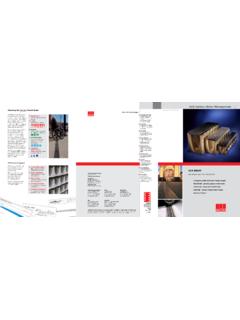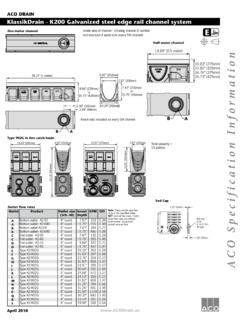Transcription of Product Catalogue and Technical Handbook - ACO …
1 Grated trench drainage systems Product Catalogue and Technical Handbook 05/17/04. The ACO Group Founded in 1946, the ACO Group manufactures products for the building and construction industry. Today, ACO employs over 3,200. people world-wide and has sales and manufacturing operations in more than 28 countries. ACO is the world leader and pioneer of modular grated trench drain systems. ACO drainage systems are used in a variety of applications from domestic environments to airports. ACO products have been used at many prestigious locations, including Olympic stadiums, since 1972. 3. Innovators ACO is the market leader in modular grated trench drain systems. ACO Drain is manufactured at the company's mod- ern manufacturing facility in Sydney. ACO Drain offers the most comprehen- sive range of grated trench drain solu- tions for every application. ACO Drain products come in a variety of widths, depths, and load ratings, with grates to suit. In conjunction with a comprehensive, quality Product range, ACO supports its business with stocking distributors, tech- nical sales support and world class cus- tomer service.
2 Contents Surface Drainage 6 Surface drainage options 8 Product selection criteria 10 Grated trench drain hydraulics 16 Loadings 20 Material data 22 End user requirements Standard Products 24 klassikdrain - K100, KS100, K200, KS200, K300, KS300. 42 PowerDrain - S100K, S200K, S300K. 56 Universal Junction Pit - Series 600. Problem Solving Products 58 SlabDrain - H100K, H100KS, H200K, H200KS, H300K, H300KS. 66 Brickslot 68 Membrane Drain 4 5. 70 MiniKlassik Technical Support and Other Information 74 Trench hydraulics service 75 Grate hydraulics service 76 Layout & scheduling service 78 Ponding analysis Key 79 Chemical resistance Load class up to D up to G. 80 Construction and installation Grate options Limited Small Wide 84 Installation diagrams 86 Specification clauses AS compliant Grates comply with AS Design for Access & Mobility 88 Part number listing Heelguard Slots/opening of less than or equal to 7mm in width 90 Glossary 91 Channel request form Surface Drainage Options for dealing with surface drainage Surface drainage is important.
3 Whether frequent light rainfall or occasional heavy downpours, surface drainage is necessary to prevent damage Grated pits to pavement or property, and reduces safety hazards caused by ponding. Surface drainage is designed to: Reduce ponding (standing water). Reduce slip hazards and subsequent injury Protect and extend life of pavements Protect property from flood damage Reduce inconvenience to public users . Uneven, undulating appearance Reduce hydroplaning on roads . Complex, multiple grades to design Water Sensitive Urban and construct Drainage Design (WSUD).. Deeper ground excavation due to pipe depths Sustainable drainage is an element of the Grated trench drains are ideal for the Options available: . Higher risk of ponding Hydrological Cycle'. It is the collection of capture and collection of storm water run- . Pipes prone to blocking and failure rainwater, its treatment and, ultimately, its off. They form a barrier to prevent . Ignore it (overland flow).
4 Maintenance can be difficult and costly reuse. rainwater run-off flowing onto the soft as access to pipe work is restricted landscaping where collection is more . Open swale . Possible interference with other The process involves capturing water difficult. This is of particular importance if services, , electrical, sewage, etc. run-off, that may or may not contain the risk of contamination is high, such as . Grated pits pollutants, so it can be dealt with in a in highway and petrol station applications.. Grated trench drains controlled manner. The water can then be treated, stored for future use, or ACO provides a wide range of trench Grated trench drainage . Neat linear appearance transported to receiving waterways. This drains to meet the hydraulic needs of any For solid pavements the first two are not . Simple grades to design and construct transfer of water should come at a low WSUD design. ideal. Grated pits or trench drains are the . Easy to install - shallower excavation cost, and cause minimal damage and most viable solutions.
5 And easy grading of pavement danger to the environment.. Continuously intercepts water along its length and provides superior drainage Surface drainage can be used where 6 . Minimal underground pipes rainwater has collected on paved areas 7.. Maintenance is quick and easy as for the capture' phase of this process. trench is at the surface and easier to access . On level pavements, can be used to contain spills or restrict runoff Product selection Choosing the correct grated trench drain When choosing a grated trench drain, the following factors should be considered: 1. Hydraulic Performance - how much liquid is to be collected and removed. 1. Hydraulic performance 2. Application - the issues relating to The volume of liquid the grated trench Important factors include: location of the drain. drain collects and carries in a given time . Width and length of catchment area period.. Rainfall intensity These factors should be addressed . Grade of pavement regardless of whether a modular channel.
6 Outlet size and position system or cast-in-situ grated trench is used. Page 10. 2. Application 2a) Loading Loading refers to any foot or vehicular Important factors include: traffic being applied to the grated trench . Weight drain.. Wheel type and size . Traffic patterns - traffic speed, Load standards are a tool to enable an frequency, braking, turning, etc. objective comparison of products by providing an independent measurement scale. Page 16. 2b) Durability To ensure long life, products must be Important factors include: carefully selected and installed correctly.. Trench material An investigation of the application's . Grate material environment is recommended to identify . Edge protection 8 9. any chemicals or other corrosive . Chemical resistance elements that may affect material . Installation choices. Page 20. 2c) User requirements There is often more than one channel, Important factors include: grate and locking option that will meet . Aesthetics hydraulic, loading and chemical resistance.
7 Legislative requirements - bicycle needs. User requirements are application safe grates specific and are determined by either . User safety - Heelguard' grates design preference or legal obligations.. Security - grate locking options Page 22. 1. Hydraulic Performance Modelling hydraulic performance of trench drains Non-uniform flow (Spatially Varied Flow). Scenario: Rainwater falls over an area and runs Non-uniform flow accounts for liquid being towards, and collects at, any low point. carried in a trench plus the constant addition of liquid collected through the grates along the trench run - lateral intake. A characteristic of non-uniform flow is that liquid velocity and height, change at successive cross sections along the trench. To correctly model this situation, differential calculus is required; usually computer modelling is used. As a result of empirical testing, ACO has developed a computer program, Hydro', to model trench hydraulics. - accurate ACO provides a complimentary service for trench hydraulics.
8 See page 74 for details. Steady, uniform flow (Manning's Theory). A traditionally used method of calculating trench hydraulics involves the use of 10 equations for steady uniform flow. 11. This approach is better suited for pipe design where liquid velocity and height remain constant along the pipe. No allowance is made for lateral intake. Steady, uniform flow can be used in Conclusion: culvert (open top) design for spillways or Grated trench drains intercept and collect irrigation trenches. These culverts are surface liquid. It is then carried to a point used to carry liquids from one area to HYDROLOGICAL where it can discharge into an another and do not account for lateral CYCLE underground pipe system or culvert. intake of liquids. - inaccurate 1. Hydraulic Performance Catchment hydraulics - calculating run-off Factors affecting trench run hydraulics To calculate the correct size trench drain, D Ground fall or slope 1. Neutral invert with ground fall catchment run-off must be calculated.
9 Catchment area - length x Slope increases the velocity of liquid width of pavement L x W within the trench drain and therefore improves hydraulic efficiency. Slope can 2. Stepped invert no ground fall . Rainfall intensity in mm per hour I Neutral invert no ground fall be introduced by: . Run-off coefficient - ie. pavement 1. Existing pavement with natural fall. material, some surfaces absorb liquids block pavers C 2. Introduce a stepped configuration 3. Sloped invert with ground fall Once catchment run-off Q is calculated, 3. Introduce slope along the base of the other inflows, downpipes, can be added. trench run. Refer to Australian Rainfall and Run-off' or 4. A combination. AS/NZS - Plumbing and Drainage 4. Combination Code' for rainfall intensities. I. W G. Other factors that affect the transfer of Effect of slope on trench hydraulic performance liquids include: L.. Ground fall along trench % D Non-uniform flow Steady Uniform flow Accurately accounts for effect of slope Uses Area x Velocity to estimate flow capacity.
10 When there is little or minimal slope, . Position and size of outlet pipe E and run length. Models the accurate velocity tends towards zero, and water depths are over-estimated. When there is C F.. Surface roughness of trench material. hydraulic performance of trench. Allows significant slope, steady uniform flow under-estimates the water depths in the trench C. D correct size of trench drain to be used. drain. Manning's coefficient of roughness - figures are available on page 21 F. Q Zero slope Zero slope . Pavement angle of approach to trench - this can affect grate hydraulics (steep slopes may cause bypass) G. E. Slope S' is the multiplier in the equation Slope is part of the equation - but not as a (Q=(1/n) AR2/3 x S1/2). For flat gradients multiplier. Trench size is accurately calculated. slope is zero and water depths cannot be 12 Determining trench size calculated, therefore trench cannot be 13. sized. The calculated run-off Q , is combined Overall dimensions Small slope Small slope with the other factors above to determine determine the physical fit of the trench in the the correct size of trench.





